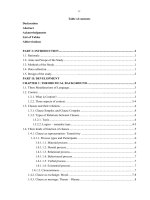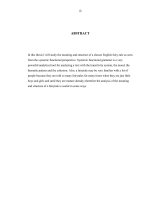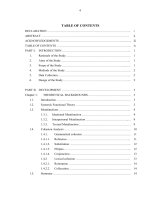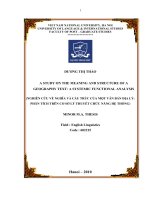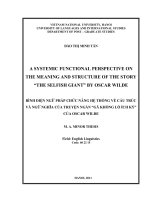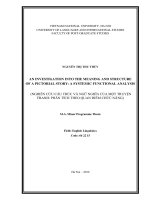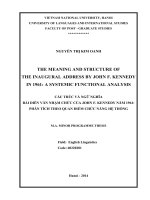the meaning and structure of a narrative a systemic functional analysis
Bạn đang xem bản rút gọn của tài liệu. Xem và tải ngay bản đầy đủ của tài liệu tại đây (177.72 KB, 39 trang )
1
CHAPTER I: INTRODUCTION
1.1. Rationale of the Study
Although functional grammar has been studied by many famous linguists in the
world such as M.A.K Halliday (1995), it has not been known much in Vietnam. Up till
now, there have been only two grammarians who have been studied from the functional
approach. The first is TiÕng Việt Sơ thảo ngữ pháp chức năng by Cao Xuân Hạo (1991)
and the second is Ngữ pháp kinh nghiệm của cú tiếng Việt mô tả theo quan điểm chức
năng hệ thống by Hoàng Văn Vân (2002). Both of them have contributed a lot to the study
of this field and brought the diagram which has not yet been highlighted in Vietnamese
schools closer to Vietnamese learners.
Functional grammar is a complex but a comprehensive model. And in order master
all its concepts and categories, it is necessary to receive the cooperation from many people.
For me, as a teacher of English, functional grammar is a really interesting and useful
branch of linguistics. It provides me with an analytic tool of looking at the whole text and
the grammatical features which are characteristics of that kind of text. For those reasons, I
would like to choose “An investigation into the meaning and structure of a narrative: a
systemic functional analysis” for my paper, using Halliday’s functional grammar as a
theoretical framework.
Hopefully, this study makes a certain contribution to the teaching and learning
English as a foreign language in Vietnam.
1.2. Aims of the Study
With in the framework of the paper, the study attempts to:
Re-examine some of the most important issues related to the experiential aspect
of functional grammar.
Analyze the meaning and structure of a narrative based on the systemic
functional analysis.
1.3. Scope of the Study
2
As stated in 1.2, the study does not cover all aspects of functional grammar but
limits itself to sub-areas of functional grammar. In other words, only issues relating to the
analysis of the text are taken into consideration.
1.4. Methods of the Study
The aim of this paper is to analyze the meanings and structures of a text. The result
should be useful for language teaching and learning. Therefore, description and analysis
are the principle methods of the study. The descriptive method is concerned with the
description of sub-areas of functional grammar as mentioned in 1.3. The analytic method is
concerned with the analysis of the text.
1.5. Data Collection
The text is a narrative text type collected from the English coursebook: The
Lifeline- Elementary. The examples are taken from grammar books by famous
grammarians like Halliday (1995) and Hoàng Văn Vân (2002), etc.
1.6. Design of the Study
The paper is designed in four chapters
Chapter one: The introduction – presents the rationale of the study, the aims of the
study, scope of the study, methods of the study, data collection, and the research
design.
Chapter two: The literature review – provides some fundamental and theoretical
concepts for the study: Systemic functional theory, metafunctions, and cohesion
analysis.
Chapter three: The analysis of the text “Torquay?, but I said Turkey!” is aimed at the
meanings and structures of the text.
The last chapter: The conclusion – summarizes the results of the study.
3
CHAPTER TWO: LITERATURE REVIEW
2.1. Introduction
This chapter will provide some theoretical orientations for the paper. We shall be
concerned with Systemic Functional theory and some features of Systemic Functional
grammar. In addition, we shall present briefly three components of meaning in language
and cohesion analysis.
2.2. Systemic Functional Theory
Systemic Functional linguistics (SFL) is a theory centered around the notion of
language function. While SFL accounts for the syntactic structure of language, it prefers
placing the function of language as central (what language does and how language does it)
rather than placing the elements of language and their combination (known as structural
approaches) as central. With in SFL, language is analyzed in terms of four strata: Context,
Semantics, Lexico-grammar, and Phonology. The context of situation is referred to as
Register which is characterized by three functional variables: Field (what is going on or the
topics and actions which language is used to express), Tenor (the social roles and
relationship between the participants), and Mode (channel of communication, e.g; spoken/
written). Semantics is the systems of meaning. Lexico-grammar includes Lexis
4
(vocabulary) and grammar in one unified system, lexis is interpreted as he most specific
part of grammar. Phonology includes the resources of intonation, rhythm, and syllabic and
phonemic articulation. These four strata has a close relation which is that of realization,
phonology realizes lexico-grammar, which realizes semantics, which realizes context.
2.3. Features of Systemic Functional Grammar
Systemic Functional Grammar is a major grammar model developed by M.A.K
Halliday. This model is called “systemic” because he developed the detailed system
networks named Mood Type for many areas of English grammar. It is called “functional”
because of his development of the theory of the ideational, interpersonal, and textual
metafunctions – functional components of meaning in language (presented in the
following section).
In general, functional approaches to grammar are different from formal models of
grammar by their focus on the communicative aspect of language.
2.4. Metafunctions
Halliday developed a theory of the fundamental functions of language into three
broad metafunctions: ideational, interpersonal, and textual. Each of the three
metafunctions is about a different aspect of the world, and is concerned with a different
mode of meaning of clauses. The ideational metafunction is about the natural world,
including our own consciousness, and is concerned with Clause as Representative. The
interpersonal metafunction is about the social world, especially the relationship between
speaker and hearer, and is concerned with Clause as Exchange. The textual metafunction is
about a verbal world, and is concerned with Clause as Messages. In each metafunction, an
analysis of a clause gives a different kind of structure composed from a different set of
elements. In the ideational metafunction, a clause is analyzed into Process, Participants,
and Circumstances, with different participant types for different process types. In the
interpersonal metafunction, a clause is analyzed into Mood and Residue, with the Mood
element further analyzed into Subject and Finite. In the textual metafunction, a clause is
analyzed into Theme and Rheme.
2.4.1. The Ideational Metafunction
5
The ideational metafunction is the means of representing reality in the linguistics. It
consists of experiential meanings and logical meanings (Halliday 1994:179). Experiential
meanings are realized through the system of TRASITIVITY. According to Halliday (1994),
the transitivity construes the world of experience into a manageable set of process types. In
the transitivity system of English, six process types are recognized: Material, Mental,
Verbal, Behavioral, Relational, and Existential.
Material Processes are processes of doing or action: running, cooking, beating,
etc. Material Processes have an obligator participant, the Actor, which is the doer of the
action. When they have two participants, the roles are referred to as respectively as Actor
and Goal. In some Material processes, the third participant appears. It is called Receiver
(one that benefits from the process). The following example provides an analysis of a
clause which reflects the Material Processes:
(a). The lion
Actor
caught
Process. material
(b). He
Actor
the tourist.
Goal
gave
a book
to her
Process. material
Goal
Receiver
Mental Processes are processes of cognition (thinking, knowing), perception
(feeling, hearing), affection (loving, hating, adoring), and desideration (wanting). In a
mental process, there are always two participants: a Sensor and a Phenomenon. The Sensor
is the participant who senses, and the Phenomenon is the one who is sensed. For example:
The boy
Sensor
loves
Process. Mental
the girl
Phenomenon
Verbal Processes are the processes of saying such as saying, speaking, talking. It is
located on the borderline of mental and relational processes. The typical participants in the
processes are the Sayer (the one who does the verbalization), the Receiver (the one to whom
the saying is addressed), the Target (the one that the verbalization is directed to), and the
Verbiage (the message itself). For example:
(a). I
asked
him
Sayer
(b). They
Process. verbal
told
a question
Receiver
Verbiage
me
so
6
Sayer
Process. verbal
Target
Circumstance
Behavioural processes are “processes of physiologic and psychological behaviour
like breathing, coughing, dreaming, smiling” (Halliday 1994:139). Typically, there is
usually one participant referred to as Behaver, and this participant is always a conscious
being. For example:
She
cried
Behaver
softly.
Process. Behavioural
Circumstance.
Relational processes are the processes of being, being at, and having. In Relational
processes, “a relation is being set up between two separate entities” (Halliday 1994:119).
This relationship can be one of two sub-types, Attribute or Identifying. When a relational
process is in the attributive mode, it has one participant referred to as Carrier, and the
quality or the thing showing that the Carrier belongs to a class of things, which is usually
realized by an adjective, is referred to as Attribute. The participants in identifying processes
are called Token and Value. In addition to the distinction between attributive and
identifying sub-types, relational processes can also be differentiated into Intensive,
Circumstantial, and Possessive relational processes. For example:
He
(a)
is
Carrier
Process. relational
She
(b)
good.
Attribute
is
Identified/Token
the best doctor.
Process. relational
Identifier/Value
Existential processes are the processes of existing. They have only one participant,
called the Existent and one or two circumstantial elements. In English existential process
clauses, the dummy subject “There” is often used. For example:
There
is
a man
Pro. existential
Existent
in the room.
Circumstance
Logical meanings are realized by relationships of co-ordination (or parataxis – the
linking of elements of equal status, the initiating and continuing elements are free) and
subordination (or hypotaxis – the linking of elements of unequal status, the dominant
element is free but the dependent one is not) between clauses and other structural units.
7
The way of analyzing a clause in term of experiential meaning produces constituency
structures whereas logical meaning are associated with interdependency structures.
2.4.2. Interpersonal Metafunction
The interpersonal metafunction is concerned with the interaction between speaker
and hearer or writer and reader. The functions within this component includes giving or
demanding information, expressing intention, expressing attitude, etc. These functions have
more to do with social interaction than with “content”. It is concerned with Clause as
Exchange.
As an exchange or an interactive event, a clause consists of two components: the
Mood and the Residue. The Mood is “the component that is bandied” (Halliday 1994:72).
Its function is to carry the argument forward. In English, the Mood comprises two parts: the
Subject (which is a nominal group) and the Finite (which is the verb element in the Mood).
The Residue is “the remainder of the clause” (Halliday 1994:74). It consists of three
functional elements: Predicator, Complement, and Adjunct. The Predicator is presented in
all non-elliptical major clauses, and is realized by a verbal group; the Complement is an
element within the Residue that has the potential of being Subject, and is typically realized
by nominal group; and the Adjunct is an element that has not got the potential of being
Subject, and is realized by an adverbial group or a prepositional phrase. For example:
Sister Susie
is
Subject
Finite
Mood
sewing
Predicator
shirts
Compliment
Residue
soldiers
Adjunct
2.4.3. Textual Metafunction
The textual meaning is described through the system of theme. Thematic structure
“gives the clause its character as a message” (Halliday 1994:37), and thus, creates
relevance to the context. The terms used to label this are called Theme and Rheme. The
Theme “served as the point of departure of the message” (Halliday 1994:37), which in
English coincides with the initial element(s) of the clause; and the Rheme is the remainder
of the message.
The Theme may be a nominal group, an adverbial group, or a prepositional phrase.
The Theme may be single or multiple, marked or unmarked. A theme is single when it
“consists of two or more groups or phrases forming a single structure element” (Halliday
8
1994:40). In contrast, a multiple is the one that has a further internal structure of its own.
Here we distinguish between Topical Theme, Textual Theme, and Interpersonal Theme. A
topical theme is the one that is conflated with an experiential element of the clause. This
means that the Theme ends with the first constituent that is either participant, circumstance,
or process. A textual theme is any combination of continuative (yes, no, now, etc),
structural (and, but...), and conjunctive (also, next, finally...). And within interpersonal
element, we may have a modal, the finite verbs (in Yes/No interrogative clause) and also a
vocative element.
In the declarative clause, an unmarked theme “is the mapping of Theme onto
Subject” (Halliday 1994:43), and a marked theme “is something other than the Subject”
(Halliday 1994:44) such as Complement, Adjunct, or even Predicator. Below are some
examples illustrating the thematic structure of the clause.
Oh
Continuative
Textual
Theme
Soldier, soldier
Vocative
Interpersonal
won’t
you
Finite
Topical
Experiential
marry me?
Rheme
I
shall complete this tomorrow.
Unmarked theme
This
I shall complete tomorrow.
Marked theme
The Theme and Rheme elements may also be classified as Given, the information
which has already introduced into the text, and New, the information which is introduced
for the first time. (For more details, see Halliday 1994.)
2.5. Cohesion Analysis
2.5.1. Reference
According to Halliday (1994: 309) “a participant or circumstantial element
introduced at one place in the text can be taken as a reference point to something that
follows”. Reference is a relationship in meaning. There are four main types of reference:
(1) anaphoric, cataphoric, and exophoric reference; (2) personal reference; (3)
demonstrative reference; and (4) comparative reference.
9
2.5.1.1. Anaphoric, Cataphoric, and Exophoric Reference
Anaphoric reference is the item(s) that “point backwards to the preceding text.”
(Halliday 1994:312). For example:
Kumiko is a Japanese professor and she works in Turkey.
Cataphoric reference is a cohesive device which points the readers or listeners
forwards – it draws us further into the text in order to identify the elements to which the
reference items refer. For example:
The two astronauts put on their spacesuits and stepped onto the planet. They
looked at everything carefully.
Exophoric reference is “a means of linking “outwards” to some person or object in
the environment” (Halliday 1994:312). For example:
The spaceship flew around the new planet several times. The planet was blue.
2.5.1.2.Personal Reference
Personal reference is “reference by means of function in the speech situation
through the category of person” (Halliday and Hasan 1997:37). For example:
The two astronauts put on their spacesuits and stepped onto the planet. Both of
them took off their helmets. They looked at everything carefully.
2.5.1.3. Demonstrative Reference
Halliday and Hasan (1997) state that demonstrative reference “is essentially a form
of verbal pointing. The speaker identifies the referent by locating it on a scale of
proximity.” For example: Leave that there and come here.
2.5.1.4. Comparative Reference
According to Halliday (1994) comparative reference “set up a relation of contrast”.
It is expressed through adjectives and adverbs and serves to compare items within a text in
terms of identity and similarity. For example:
- It is the same cat as the one we saw yesterday.
- “Would you like these eggs?” “No, as a matter of fact, I’ d like the other eggs.”
- The little dog barked as noisily as the bigger one.
2.5.2. Substitution
10
According to Halliday and Hasan (1997) substitution is “a relation between
linguistic items such as words or phrases”. It can be thought of as processes of the
replacement of one item by another with in a text. There are three types of substitution:
nominal substitution, verbal substitution, and clausal substitution.
2.5.2.1. Nominal Substitution
Nominal substitution is the use of a substitute word to replace the Head of a
corresponding nominal group. The noun functioning as the Head is always a count noun. In
English, nominal substitution is realized by the words such as one, ones, and the same. For
example:
-These biscuits are stale. Get some fresh ones.
- I’ll have a poached egg on toast, please. – I’ll have the same.
2.5.2.2. Verbal Substitution
The verbal substitute in English is do. This functions as Head of a verb group and
something substitutes for a verb which is Head of a verbal group. Its position is always at
the end of the group. For example:
...the words did not come the same as they used to do.
2.5.2.3. Clausal Substitution
Clausal substitution is the one “in which what is presupposed is not an element with
in the clause but an entire clause” (Halliday and Hasan 1997:130). The words used as
substitutes are so and not. For example:
-
Is there going to have an earthquake? - It says so.
- Will he come tomorrow? – I think not.
2.5.3. Ellipsis
Another form of anaphoric cohesion in the text is ellipsis. Ellipsis can be thought of
as the omission of an item with in the text. Like substitution, ellipsis can be studied in
terms of nominal ellipsis, verbal ellipsis, and clausal ellipsis.
2.5.3.1. Nominal Ellipsis
At the experiential level, a nominal group is realized by the structure of “Deictic +
Numerative + Epithet + Classifier + Thing” (Halliday 1994:180), e.g. Those two old
electric trains. When the thing is omitted, the Head will be taken on by one of the other
elements. For example:
A: I like the blue hat.
11
B: I like the green.
2.5.3.2. Verbal Ellipsis
By verbal ellipsis, we mean ellipsis with in the verbal group. For example:
-
Have you been swimming? – Yes, I have.
-
What have you been doing? – Swimming.
2.5.3.3. Clausal Ellipsis
Clausal ellipsis is related to the question-answer process in dialogue. There are two
kinds: Yes /No ellipsis and Wh- ellipsis. In addition, there may be ellipsis of the whole
clause or just one part of it. For example:
“Julia has gone to HCM City this morning.” “Has she? She didn’t tell me.”
2.5.4. Conjunctive Cohesion
Conjunction is a type of cohesion that “constitutes a cohesive bond between two
clauses” (Halliday 1994:180). There are different classifications of conjunction. In the
scope of this paper, we would like to focus on three categories: Elaboration, Extension, and
Enhancement.
2.5.4.1. Elaboration
In elaboration, “one clause elaborates on the meaning of another by further
specifying or describing it” (Halliday 1994: 225). There are two types of elaboration: (1)
apposition in which some element is represented or restarted; e.g. in other words, that is
(to say), for example, thus, etc.; (2) clarification in which some element is reinstated,
summarized, made more precise such as actually, in fact, in conclusion, in particular,
anyway, at least, as I was saying, etc.
2.5.4.2. Extension
Halliday (1994) states that in extension “one clause extends the meaning of another
by adding something new to it”. There are two types of extension: (1) addition which
consists of positive (moreover, in addition, also, and), negative (nor), or adversative (on
the other hand, however, but, yet); and (2) variation which consists of replacive (on the
contrary, instead), subtractive (apart from that, except), and alternative (alternatively).
2.5.4.3. Enhancement
12
According to Halliday (1994) in enhancement one clause enhances the meaning of
another by “qualifying it in one of a number of possible ways”. There are four types of
enhancement: spatio-temporal, manner, causal-conditional, and matter.
Spatial conjunctions are used as cohesive devices which create text. They may be
adverbs like behind, nearby; place reference like here, there; or expressions containing a
place noun or adverb plus reference item like in the same place, anywhere else.
Temporal conjunctions comprise a number of different relations. The expressions
may be simple with following (then, next), simultaneous (just then), preceding (before that)
or conclusive (finally); or complex with immediate (at once), repetitive (next time), specific
(next day), etc.
Manner conjunctions create cohesion by comparison (likewise, similarity, in a
different way) and by reference to means (thus, thereby).
Causal conjunctions occur in many types of discourse as “cohesive agent”. Some
cause expressions are general (so, then, therefore, consequently), others relate specifically
to result (as a result), reason (for that reason), or purpose (for that purpose).
Positive, negative, and concessive are three subdivisions in conditionals. The
positive expressions are then, in that case, etc; the negative expressions are otherwise, if
not; and the concessive expressions are yet, though, however, nevertheless, etc.
Matter conjunctions crate cohesion by “reference to the matter that has gone
before”. Typical matter expressions are here, there, in that respect, elsewhere.
There is also another classification of conjunction in which four types are
recognized. They are: adversative, additive, temporal, and causal. (For more detail, see
Halliday and Hasan 1997).
2.5.5. Lexical Cohesion
Lexical cohesion occurs when “the selection of items that are related in some way
to those that have gone before” (Halliday 1994:330). Halliday and Hasan (1997) classify
lexical cohesion into two main categories: reiteration and collocation.
2.5.5.1. Reiteration
Under reiteration, there are five subtypes: repetition, synonymy, antonymy,
superordinate and meronymy, and general word.
13
2.5.5.1.1. Repetition
Repetition refers to the same lexical item with the same meaning occurring more
than one in the same discourse. For example:
Ally met a bear. The bear was bulgy.
2.5.5.1.2. Synonymy
Synonymy refers to the choice of a lexical item that in some sense bears the same
meaning or nearly the same meaning with a preceding one. For example:
He was just wondering which road to take when he was startled by a sound from
behind him. It was the noise of trotting horses.
2.5.5.1.3. Antonymy
Antonymy refers to the lexical items which are opposite in meaning.
He fell asleep. What woke him was a loud crash.
2.5.5.1.4. Superordinate and meronymy
It can be understood that superordinate is synonyms of some higher level of
generality. In this type of cohesion, there are two other items which are particular variants
of synonymy: hyponymy and meronymy.
Hyponymy presents a specific/general relationship. The relation between the two
lower terms is that of co-hyponym. For example:
Tree: oak, pine, elm.
Vehicle: car, bus, coach, motorbike.
Meronymy presents a part/whole relationship. The relation between two parts is that
of co-meronym. For example:
Tree: trunk, branch, leaf, root.
Car:
door, driving wheel, headlight.
2.5.5.1.5. General Word
According to Halliday and Hasan (1997), the class of general noun is “a small set
of nouns having generalized reference within the major noun class”, such as “human
noun”: people, man, woman, child; “object noun”: thing, object; “place noun”: place. These
items are often neglected in the description of English, but people place a significant part in
14
verbal interaction, and are also an important source of cohesion in spoken language.
Illustrations are:
I turned to the ascent of the peak. The thing is perfectly easy.
There is a boy climbing the old elm. That old thing in not safe.
2.5.5.2. Collocation
Collocation refers to lexical cohesion that “is achieved through the association of
lexical items that regularly co-occur” (Halliday and Hasan 1997:284). In this category of
lexical cohesion, there are three types:
Resultative collocation refers to the relation of one item leading to the outcome of
another item such as kill-die, dark-night, wind-blow.
Modificational collocation refers to the relation holding between an item and one
of its inherent qualities such as run-fast/slowly, rain-heavy, sun-bright.
Contextual collocation refers to the co-occurrence of words in one context but in
other context they are not related, e.g. teacher-teach/explain, student-study/learn.
2.6. Concluding Remarks
In this chapter, we have mentioned some fundamental and theoretical concepts
relevant to the purposes of the paper. We presented briefly systemic functional linguistics.
In SFL, the semantics level is organized into three metafunctions: (1)the ideational with
which a clause is analyzed into Process, Participants, and Circumstances with different
participant types for different process types; (2) the interpersonal with which a clause is
analyzed into Mood and Residue; and (3) the textual with which a clause is analyzed into
Theme and Rheme. We also presented five main types of cohesion which we think are
useful for text analysis: reference, substitution, ellipsis, conjunction, and lexical cohesion.
In the next chapter, the analysis of the text “Torquay? But I said Turkey!” based on
the systemic functional approach will be provided.
CHAPTER THREE:
THE MEANING AND STRUCTURE OF THE TEXT
“TORQUAY? BUT I SAID TURKEY!”
Torquay? But I said Turkey!
15
Kumiko Tsuchida is a Japanese professor and she works in Turkey at Istanbul
University. Last week she took a short holiday in London. She had a good time and after a
few days she packed her suitcase, checked out of the hotel and set off to catch her flight
back to Istanbul.
At Paddington station, she couldn’t find the train to the airport, so she asked a
railway guard. Mrs Tsuchida doesn’t speak very much English, and when she said
“Turkey”, the guard thought she said “Torquay”, a seaside town in South-West England. So
he directed her to the platform for 8.15 train to Torquay.
Mrs Tsuchida got on the train. The journey seemed very long. She arrived in the
seaside town just after midnight, but when she got off the train, she didn’t recognize
anything. She didn’t know where she was. She was very frightened.
Two hours later, the police found her. They provided a bed for her for the night and
the next morning they phoned the Japanese embassy. The embassy sorted out the problem.
Then Mrs Tsuchida got the train back to London, took a taxi to Heathrow airport, and
caught anoher flight to Istanbul.
Before she left, she spoke to our reporter through an interpreter. “I said “Turkey”
but people didn’t understand my pronunciation and they thought I said “Torquay”. But I
enjoyed my visit and English people are very helpful and kind.”
Torquay? But I said Turkey!
I
1. Kumiko Tsuchida is a Japanese professor
2. and she works in Turkey at Istanbul University.
II
3. Last week she took a short holiday in London.
III
4. She had a good time
5. and after a few days she packed her suitcase,
6. checked out of the hotel
7. and set off to catch her flight back to Istanbul.
IV
8. At Paddington station, she couldn’t find the train to the airport,
9. so she asked a railway guard.
V
10. Mrs Tsuchida doesn’t speak very much English,
16
11. and when she said “Turkey”,
12. the guard thought
13. she said “Torquay”, a seaside town in South-West England.
VI
14. So he directed her to the platform for 8.15 train to Torquay.
VII
15. Mrs Tsuchida got on the train.
VIII
16. The journey seemed very long.
IX
17. She arrived in the seaside town just after midnight,
18. but when she got off the train,
19. she didn’t recognize anything.
X
20. She didn’t know
21. where she was.
XI
22. She was very frightened.
XII
23. Two hours later, the police found her.
XIII
24. They provided a bed for her for the night
25. and the next morning they phoned the Japanese embassy.
XIV. 26. The embassy sorted out the problem.
XV
27. Then Mrs Tsuchida got the train back to London,
28. took a taxi to Heathrow airport,
29. and caught anoher flight to Istanbul.
XVI
30. Before she left,
31. she spoke to our reporter through an interpreter.
XVII 32. “I said “Turkey”
33. but people didn’t understand my pronunciation
34. and they thought
35. I said “Torquay”.
XVIII 36. But I enjoyed my visit
37. and English people are very helpful and kind.”
3.1. Introduction
It is undeniable that there is a number of definitions of the term “text”. In a
common sense, a text can be defined as “a written or spoken passage” (Collin Cobuild
17
English Dictionary – 1999). Linguistically, the word Text is used to “... refer to any
passage, spoken or written, of what ever length, that does form a unified whole... It is a unit
of language in use... It is best regarded as a semantic unit.” (Halliday and Hasan, 1997).
However, in order to understand this term clearly and correctly, it is not an
easy task.
With these difficulties in mind, an attempt is made to explore the meaning and
structure of “Torquay? But I said Turkey!” as a text. The analysis
is based on the
framework of Halliday’s (1994)An Introduction to Functional Grammar, Halliday and
Hasan’s (1997) Cohesion in English, Hoàng Văn Vâns (2000) Ngữ pháp kinh nghiệm của
cú tiếng Việt mô tả theo quan điểm chức năng hệ thèng.
The analysis will proceed from the context of the chosen text; clauses and clause
complexes; the transitivity pattern; the mood pattern; the theme – rheme pattern; the
grammatical cohesion, to a summary of the context of situation of the text in terms of the
three contextual parameters: field, tenor, and mode.
3.2. The Context of the Chosen Text
The chosen text is taken from an English book “Lifeline – Elementary” by Tom
Hutchison published by Oxford University Press. It is unit 10 with the topic of travel. The
title of the text is “Torquay? But I said Turkey!” Between two columns of the text, there is
a picture of woman, two maps of United Kingdom and Turkey. The woman is holding a
ticket and a visa. The text is used to develop reading and writing skills. Time allowance for
the text is 90 minutes.
3.3. Clauses and clause complexes
The text consists of 37 clauses which make up 18 clause complexes. Most of the
clauses in the clause complexes are in paratactic relation. Their semantic relations are of
elaboration, extension, and enhancement. There are only two clause complexes, which have
hypotactic relation (X and XVI).
Boundary Markers used for this text analysis
: clause complex boundary
18
: clause boundary
Type of dependence:
(1.1) (1.2) (1.3) ...
paratactic relation
()
hypotactic relation
() ...
Logio-semantic relations: = : elaboration
+ : extension
Others:
I, II, III, ...:
x : enhancement
number of clause complex in the whole text
(1), (2), (3), ...:number of clause in the whole text
1, 2, 3, ...:
I
number within a clause complex
(1)
1
(1.1) + (1.2)
2
II
(3)
(1.1)
1
III
(4)
1
2
(1.1) + (1.2) = (1.3) = (1.4)
3
4
IV
(8)
(1.1) x (1.2)
1
2
V
(10)
1
2
3
4
(1.1) = (1.2) = (1.3) = (1.4)
19
VI
(14)
1
VII
(15)
1
VIII
(1.1)
(16)
1
IX
(1.1)
(1.1)
(17)
1
2
(1.1) + (1.2) + (1.3)
3
X
(20)
1
(1) = (1)
2
XI
(22)
1
XII
(23)
1
XIII
(1.1)
(1.1)
(24)
1
(1.1) x (1.2)
2
XIV
(26)
1
(1.1)
20
XV
(27)
1
2
(1.1) = (1.2) = (1.3)
3
XVI
(30)
1
(1. ) +
2
XVII
(1. )
(32)
1
2
(1.1) = (1.2) = (1.3) = (1.4)
3
4
XVIII
(36)
1
(1.1) + (1.2)
2
3.4. The Analysis of the Patterns
1.
Transitivity
Mood
Theme
2.
Transitivity
Mood
Kumiko Tsuchida
Identified
Subject
Mood
Theme
And
Theme
Textual
Theme
3.
Transitivity
Mood
Last week
Adjunct
Residue
is
Process. relational
Finite Predicate
she
works
Actor
Process. material
Subject Finite Predicate
Mood
Topical
Theme
she
took
Actor
Process. material
Subject Finite Predicate
Mood
a Japanese professor
Identifier
Complement
Residue
Rheme
in Turkey at Istanbul University
Circumstance
Adjunct
Residue
Rheme
a short holiday
Goal
Complement
Residue
in London
Circumstance
Adjunct



